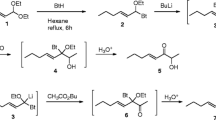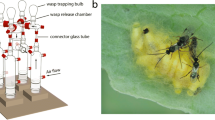Abstract
Observations in the laboratory and in the field indicated that maleAnticarsia gemmatalis (Hübner), the velvetbean caterpillar (VBC), are attracted to conspecific courting males. Male VBC subsequently were found to be attracted to extracts of male abdominal tips including the extrudable hairpencils. The active chemical in these extracts was identified as (Z,Z,Z)-3,6,9-heneicosatriene, which is also one of the major components of the female VBC sex pheromone. Male VBC in a wind tunnel and in the field exhibited a bimodal response distribution to a range of ratios of the (Z,Z,Z)-3,6,9-heneicosatriene and (Z,Z,Z)-3,6,9-eicosatriene, with one maximum at the pure heneicosatriene alone and the other at the 60∶40 female blend. This demonstrates that the male response to the male hairpencil component is distinct from that to the female sex pheromone.
Similar content being viewed by others
References
Baker, T.C. 1983. Variations in male Oriental fruit moth courtship patterns due to male competition.Experientia 39:112–114.
Baker, T.C., Nishida, R. andRoelofs, W.L. 1981. Close-range attraction of female Oriental fruit moths to herbal scent of male hairpencils.Science 214:1359–1361.
Brownlee, R.C., andSilverstein, R.M. 1968. A micro-preparative gas chromatograph and a modified carbon skeleton determination.Anal. Chem. 40:2077–2079.
Birch, M.C. 1974. Aphrodisiac pheromones in insects, pp. 115–134,in M.C. Birch (ed.). Pheromones. Elsevier, New York.
Duncan, D.B. 1955. Multiple range and multipleF tests.Biometrics 11:1–41.
Greene, G.L. 1974. Sexual dimorphism ofAnticarsia gemmatalis leg scales.Fla. Entomol. 57:280.
Hartstack, A.W.J., Witz, J.A. andBuck, D.R. 1979. Moth traps for the tobacco budworm.J. Econ. Entomol. 72:519–522.
Heath, R.R., Jordan, J.R., Sonnet, P.E., andTumlinson, J.H. 1979. Potential for the separation of insect pheromone by gas chromatography on columns coated with cholesteryl cinnamate, a liquid-crystal phase.J. HRC 7 CC 2:712–714.
Heath, R.R., Tumlinson, J.H., Leppla, N.C., McLaughlin, J.R., Dueben, B., Dundulis, E., andGuy, R.H. 1983. Indentification of a sex pheromone produced by female velvetbean caterpillar moth.J. Chem. Ecol. 9:645–656.
Heath, R.R., Teal, P.E.A., Tumlinson, J.H., andMengelkoch, L.J. 1986. Prediction of release ratios of multicomponent pheromones from rubber septa.J. Chem. Ecol. 12:2133–2143.
Hendricks, D.E., andShaver, T.N. 1975. Tobacco budworm: Male pheromone suppressed emission of sex pheromone by the female.Environ. Entomol. 4:555–558.
Hirai, K., Shorey, H.H., andGaston, L.K. 1978. Competition among courting male moths: male to male inhibitory pheromone.Science 202:644–645.
Krasnoff, S.B., andVick, K.W. 1984. Male-produced wing-gland pheromone ofEphestia elutella.J. Chem. Ecol. 10:667–679.
Leppla, N.C. 1985.Anticarsia gemmatalis, pp. 189–196,in P. Singh and R. F. Moore (eds.). Handbook of Insect Rearing, Vol. 2. Elsevier, Amsterdam.
Leppla, N.C., Guy, R.H., Heath, R.R., andDueben, B. 1987. Courtship and chemical communication of the velvetbean caterpillar moth.Ann. Entomol Soc. Am. 80:278–283.
Mitchell, E.R., andHeath, R.R. 1986. Pheromone trapping system for the velvetbean caterpillar (Lepidoptera: Noctuidae).J. Econ. Entomol. 79:289–292.
Willis, M.A. andBirch, M.C. 1982. Male lek formation and female calling in a population of the arctiid mothEstigmene acrea.Science 218:168–170.
Author information
Authors and Affiliations
Additional information
This article reports the results of research only. Mention of a proprietary product does not constitute an endorsement or the recommendation for its use by USDA.
Rights and permissions
About this article
Cite this article
Heath, R.R., Landolt, P.J., Leppla, N.C. et al. Identification of a male-produced pheromone ofAnticarsia gemmatalis (Hübner) (Lepidoptera; Noctuidae) attractive to conspecific males. J Chem Ecol 14, 1121–1130 (1988). https://doi.org/10.1007/BF01019340
Received:
Accepted:
Issue Date:
DOI: https://doi.org/10.1007/BF01019340




